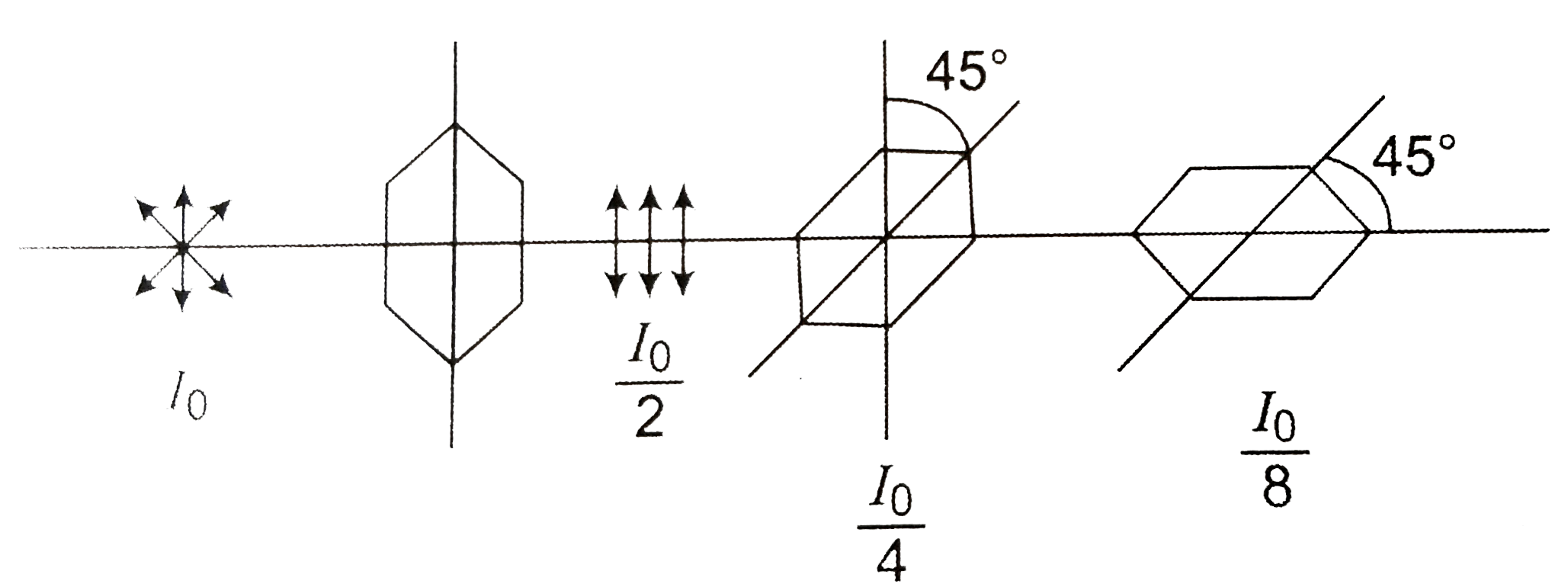Two polaroids P1 and P2 are placed with their axis perpendicular to each other. Un-polarized light I0 is incident on P1. A third polaroid P3 is kept in between P1 and P2 such that its axis makes an angle 45∘ with that of P1. The intensity of transmitted light through P2 is
I04
I08
I016
I02
The correct Answer is:B

I=I'cos2θ
Topper's Solved these Questions
Similar Questions
Two Polaroids P1 and P2 are placed with their axis perpendicular to each other. Unpolarized light I0 is incident on P1. A third polaroid P3 is kept in between P1and P2 such that its axis makes an angle 45∘ with that of P1. Then intensity of transmitted light through P2 is I0n. Find n.
View Solution(a) Using the phenomenon of polarisation, show how transverse nature of light can be demonstrated.
(b) Two polaroids P1andP2 are placed with their pass axes perpendicular to each other. Unpolarised light of intesity I0 is incident on P1. A third polaroid P3 is kept in between P1 and P2 such that its pass axis makes an angle of 30∘ with that of P1. Determine the intensity of light transmitted through P1,P2andP3.View Solution
Knowledge Check
- Question 1 - Select One
Two Polaroids P1 and P2 are placed with their axis perpendicular to eachother. Unpolarised light I0 is nicident on P1. A third polaroid P3 is kept in between P1 and P2 such that its axis makes an angle 45∘ with that of P1. The intensity of transmitted light through P2 is
AI02BI04CI08DI016 - Question 2 - Select One
Two Polaroids P1 and P2 are placed with their axis perpendicular to eachother. Unpolarised light I0 is nicident on P1. A third polaroid P3 is kept in between P1 and P2 such that its axis makes an angle 45∘ with that of P1. The intensity of transmitted light through P2 is
AI04BI08CI016DI02
(a) Using the phenomenon of polarization, show, how, transverse nature of light can be demonstrated.
(b) Two polaroids P1andP2 are placed with their pass axes perpendicular to each other. Unpolarised light of intensity 10 is incident on P1. A third polaroid P3 is kept in between P1andP2 such that its pass axis makes an angle of 30∘ with that of P1. Determine the intensity transmitted through P1,P2andP3.View SolutionExplain, with the help of a diagram, how plane polarised light can be produced by scattering of light from the Sun.
Two polaroids P1andP2 are placed with their pass axes perpendicular to each other. Unpolarised light of intensity I is incident on P1. a third polaroid P3 is kept between P1andP2 such that its pass axis makes an angle of 45∘ with that of P1. calculate the intensity of light transmitted through P1,P2andP3.View Solution(a) Using the phenomenon of polarisation, show how transverse nature of light can be demonstrated.
(b) Two polaroids P1andP2 are placed with their pass axes perpendicular to each other. Unpolarised light of intensity I0 is incident on P1. a third polaroid P3 is kept in between P1 and P2 such that its pass axis makes an angle of 30∘ with that of P1. determine the intensity of light transmitted through P1,P2andP3.View SolutionUnpolarised light of intensity I0 passes through two polaroids P1andP2 such that pass axis of P1. A third polaroid P3 is placed between P1andP2 with pass axis of P3 making an angle 60∘ with that of P1. Determine the intensities of light transmitted by P1,P2andP3.
View SolutionTwo polarioids P1andP2 are placed in crossed positions. A third polaroid P3 is kept between P1andP2 such that the axis of P3 is parallel to that of P1. How would the intensity of light (I2) transmitted through P2 vary as P3 is rotated? Draw a plot of intensity 'I2' vs the angle 'θ' between the axes of P1andP3. In which orientation will the transmitted intensity be (i) minimum and (ii) maximum?
View SolutionThe polaroids P1 and P2 are placed in crossed position. A third polaroid P3 is kept between P1 and P2 such that pass axis of P3 is parallel to that of P1. How would the intensity of light (I2) transmitted through P2 vary as P3 is rotated ? Draw plot of intensity I2 versus angle θ between pass axis of P1 and P3. In which orientation will the transmitted intensity be minimum and maximum ?
View Solution

